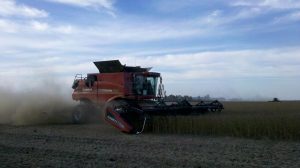Agronomy, Conservation, Homepage Slider
Soil compaction, choices and patience
By Dusty Sonnenberg, CCA, Ohio Field Leader
Management requires measurement. There are two forms of soil compaction that can be measured and then managed, said John Fulton, associate professor at the Ohio State University in Agricultural and Biosystems Engineering at the recent Precision University 2020 meeting.
“To effectively manage compaction we need to both understand it and measure it. The first is surface compaction. This is the compaction that occurs at the upper soil layer. It is considered to be within the tilled layer of soil. The second is subsoil or deep compaction. Subsoil compaction occurs below the tilled layer as a result of surface loading,” Fulton said. “There are four stages when dealing with compaction issues. They include: identifying areas of soil compaction,

evaluating those compacted areas to determine both the cause and also severity, making plans to prevent future compaction, and developing plans to manage existing compaction.”
Soil compaction can be defined as soil particles being compressed together and reducing the pore space. Compaction has several negative impacts on agricultural production. Soil compaction decreases water infiltration and reduces a soil’s water holding capacity. It reduces both a plant’s root growth and rooting depth, as well as nutrient uptake. Compaction can lead to increased soil erosion and as a result, increased water quality issues. Ultimately soil compaction will impact profitability by increasing a farmer’s input costs, and reduce final yields.
And, given the weather pattern over much of Ohio for the past year and a half, many farmers have had to accept some level of compaction that will have to be managed. While most have made the decision to conduct field operation under less than desirable conditions, Ian McDonald from the Ontario Ministry of Agriculture reminded Precision University 2020 participants that the compaction in their fields was a conscious management decision.
“Soil compaction is a management decision. It is about the choices we make and how much patience we have,” McDonald said. “It is something farmers need to take responsibility for and consider just as much as the varieties they select or tillage equipment they use and when they decide to use it. It is a part of the system they have selected to operate. Agriculture does not operate without a system, and the management of compaction is a part of that.”
The complexities of soil compaction, though, can make management very challenging.
“Soil compaction is complicated,” McDonald said. “There are a number of variables that factor into the level of compaction being measured and the management decisions that need to be made. When compaction is measured, we see  the impact of cyclic loading.”
the impact of cyclic loading.”
An example is when a combine gradually gets heavier as the grain tank fills while it is making a pass across the field. The reverse is true when manure or fertilizer application equipment gets lighter as it makes the application across a field.
“There are also variation in the field landscape in terms of soil type and soil moisture or drainage,” McDonald said.

“These all factor into the level of compaction that occurs.”
Another challenge in measuring soil compaction is the harvest width of combines.
“Yield monitors tend to hide specific compaction areas, such as wheel tracks, because they average the yield across the pass being harvested. The impact is occurring underground which is much less visible to us, even the above ground response may not reveal the true whole system impact. This makes it difficult to determine compaction costs,” McDonald said.
Management decisions impacting soil compaction include the timing of field operations, as well as the types of field operations being conducted. The frequency and aggressiveness of those operations, which would include the weight and configuration of the equipment used. Other considerations include crop selection and rotation, along with the level of soil organic matter, and other organic amendments added to the soil.